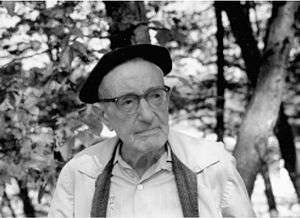Dirk Jan Struik
| Dirk Jan Struik | |
|---|---|
|
Dirk Jan Struik | |
| Born |
September 30, 1894 Rotterdam, Netherlands |
| Died |
October 21, 2000 (aged 106) Belmont, Massachusetts, U.S. |
| Residence | Netherlands, U.S. |
| Nationality | Dutch |
| Fields | Multidimensional geometry, History of mathematics |
| Institutions | Massachusetts Institute of Technology, Delft University of Technology |
| Alma mater | University of Leiden |
| Doctoral advisor |
W. van der Woude Jan Schouten |
| Doctoral students |
Joseph Dauben Judith Grabiner Eric Reissner |
| Known for | A concise history of mathematics; A source book in mathematics 1200–1800 |
| Notable awards | Kenneth O. May Prize (1989) |
Dirk Jan Struik (September 30, 1894 – October 21, 2000) was a Dutch mathematician and Marxian theoretician who spent most of his life in the United States.
Life
Dirk Jan Struik was born in 1894 in Rotterdam, Netherlands, as a teacher's son, Struik attended the Hogere Burgerschool (HBS) in The Hague. It was in this school that he was first introduced to left-wing politics by some of his teachers.
In 1912 Struik entered University of Leiden, where he showed great interest in mathematics and physics, influenced by the eminent professors Paul Ehrenfest and Hendrik Lorentz.
In 1917 he worked as a high school mathematics teacher for a while, after which he worked as a research assistant for J.A. Schouten. It was during this period that he developed his doctoral dissertation, "The Application of Tensor Methods to Riemannian Manifolds."
In 1922 Struik obtained his doctorate in mathematics from University of Leiden. He was appointed to a teaching position at University of Utrecht in 1923. The same year he married Ruth Ramler,[1] a Czech mathematician with a doctorate from the Charles University of Prague.
In 1924, funded by a Rockefeller fellowship, Struik traveled to Rome to collaborate with the Italian mathematician Tullio Levi-Civita. It was in Rome that Struik first developed a keen interest in the history of mathematics. In 1925, thanks to an extension of his fellowship, Struik went to Göttingen to work with Richard Courant compiling Felix Klein's lectures on the history of 19th-century mathematics. He also started researching Renaissance mathematics at this time.
In 1926 Struik was offered positions both at the Moscow State University and the Massachusetts Institute of Technology. He decided to accept the latter, where he spent the rest of his academic career. He collaborated with Norbert Wiener on differential geometry, while continuing his research on the history of mathematics. He was made full professor at MIT in 1940.
Struik was a steadfast Marxist. Having joined the Communist Party of the Netherlands in 1919, he remained a Party member his entire life. When asked, upon the occasion of his 100th birthday, how he managed to pen peer-reviewed journal articles at such an advanced age, Struik replied blithely that he had the "3Ms" a man needs to sustain himself: Marriage (his wife, Saly Ruth Ramler, was not alive when he turned one hundred in 1994), Mathematics, and Marxism.
It is therefore not surprising that Dirk suffered persecution during the McCarthyite era. He was accused of being a Soviet spy, a charge he vehemently denied. Invoking the First and Fifth Amendments of the U.S. Constitution, he refused to answer any of the 200 questions put forward to him during the HUAC hearing. He was suspended from teaching for five years (with full salary) by MIT in the 1950s. Struik was re-instated in 1956. He retired from MIT in 1960.
Aside from purely academic work, Struik also helped found the Journal of Science and Society, a Marxian journal on the history, sociology and development of science.
In 1950 Struik published his Lectures on Classical Differential Geometry,[2] which gained praise from Ian R. Porteous:
- Of all the textbooks on elementary differential geometry published in the last fifty years the most readable is one of the earliest, namely that by D.J. Struik (1950). He is the only one to mention Allvar Gullstrand.[3]
Struik's other major works include such classics as A Concise History of Mathematics (1948),[4] Yankee Science in the Making, The Birth of the Communist Manifesto, and A Source Book in Mathematics, 1200–1800, all of which are considered standard textbooks or references.
Struik died October 21, 2000, 21 days after celebrating his 106th birthday.
Bibliography
- D. J. Struik, editor, A source book in mathematics, 1200–1800 (Princeton University Press, Princeton, New Jersey, 1986). ISBN 0-691-08404-1, ISBN 0-691-02397-2 (pbk).
- D. J. Struik, A concise history of mathematics, fourth revised edition (Dover Publications, New York, 1987). ISBN 0-486-60255-9, ISBN 978-0-486-60255-4.
References
- ↑ "Élie Cartan et Saly Ruth Ramler – Médias – MSN Encarta". Archived from the original on 2009-10-31.
- ↑ Bompiani, E. (1951). "Review: Lectures on classical differential geometry by D. J. Struik" (PDF). Bull. Amer. Math. Soc. 57 (2): 154–155. doi:10.1090/s0002-9904-1951-09487-2.
- ↑ Ian R. Porteous (2001) Geometric Differentiation, p 319, Cambridge University Press ISBN 0-521-00264-8
- ↑ Rowe, David E. (2001). "Looking back on a bestseller: Dirk Struik's A Concise History of Mathematics" (PDF). Notices Amer. Math. Soc. 48 (6): 590–592.
Sources
- Obituaries
- G. Alberts, and W. T. van Est, Dirk Jan Struik, Levensberichten en herdenkingen (Koninklijke Nederlandse Akademie van Wetenschappen, 2002), pp. 107–114. ISBN 90-6984-343-9
- MIT News Office (2000-10-25). Mathematician Professor Dirk Struik dies at 106. Massachusetts Institute of Technology, accessed 2007-07-23
External links
- Chandler Davis, Jim Tattersall, Joan Richards, and Tom Banchoff, Dirk Jan Struik (1894–2000)
- O'Connor, John J.; Robertson, Edmund F., "Dirk Jan Struik", MacTutor History of Mathematics archive, University of St Andrews.
- Dirk Jan Struik's Biography
- Dirk Jan Struik at the Mathematics Genealogy Project
- Works by or about Dirk Jan Struik in libraries (WorldCat catalog)
